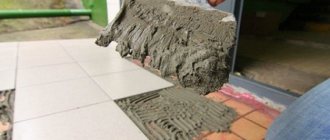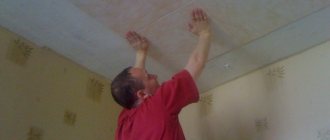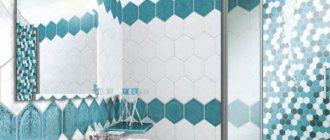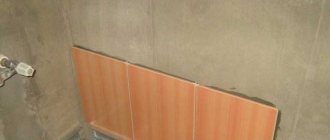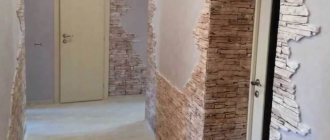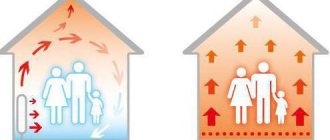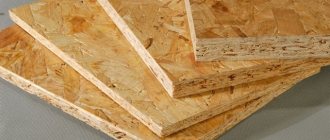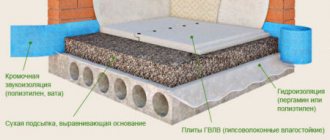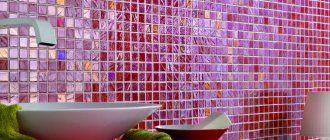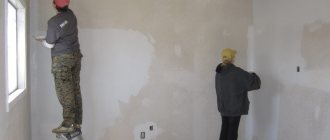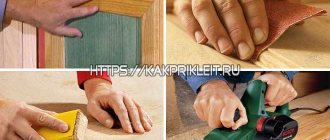Ceramic tiles are one of the most common finishing materials. If there is no flat surface, tiles in the bathroom are laid on gypsum fiber board or gypsum fiber sheets. Installation can be carried out on the floor or wall, regardless of the type of coating. The sheets are securely attached to concrete, brick and other bases, which makes this material truly universal.
Laying tiles on GVL
In addition, gypsum boards differ from standard plasterboard sheets or gypsum boards in their reliability, durability, and long service life. Gypsum fiber sheets are characterized by high performance characteristics, so they are excellent as a base for laying tiles on floors and walls. By and large, installation of the material is no different from ordinary drywall, so no extra tools or skills are required.
Laying tiles on the gvl floor
Tile is the material most often used in finishing the kitchen, hallway or bathroom. Today, there is the option of laying tiles on GVL, which allows you to quickly obtain a high-quality floor covering that has a number of advantages. Firstly, it should be noted its sound and heat insulating properties. Secondly, such a floor is moisture resistant and is characterized by resistance to high temperatures.
Laying ceramic coating
Before laying the tiles, all necessary measurements and calculations are made. This includes counting the number of tiled covering elements. Material calculations are carried out by piece, and not in square meters. The features of the pattern, color, shape of the room, etc. are taken into account.
Next, choose a laying scheme. The following are considered interesting and often chosen: classic pattern (straight or horizontal), diagonal, herringbone, typesetting, inverse, diamond, square.
The classic styling option is the most common. The elements are laid out from the center of the floor or wall surface. To calculate the center point of the floor, strings are pulled at an angle of 90 degrees, dividing the plane into 4 rectangles.
For diagonal laying, such markings are supplemented by tensioning cords from the corners of the base. The installation procedure in this case is more complex.
Advantages of GVL
Gypsum fiber sheets have a number of common characteristics with plasterboard. However, this material also has its own characteristics that make it more perfect. Just like gypsum board, gypsum board sheets consist of gypsum with the addition of cellulose material. However, during the production process, gypsum fiber boards are not glued with cardboard on both sides. In addition, thanks to the addition of special components, gypsum fiber sheets are fire-resistant and more water-resistant.
GVL flooring is an excellent solution for creating a dry floor screed, as it is highly durable. This floor can be installed in any room. However, when laying tiles on the floor in rooms with high humidity, special moisture-resistant GVLV sheets should be used.
Tools and materials for installation work
It is impossible to do without piece counting of materials. To do this, you can arm yourself with a calculator, pen and notepad, or enter data into an online calculator for calculating facing materials. Do not forget about openings and niches, complex corners and turns, since the final number of building materials for laying tiles on the surface can vary to a greater or lesser extent.
However, it is not worth taking an even number of slabs. According to experts, all building materials are purchased with an expectation of 10–15%, since operating conditions involve errors. We should not exclude defective parts (manufacturing or received during the installation process).
Accessories for drywall installation
To install GVL (GVLV), you will need the following tools and building materials:
- GVL sheets (GLVL);
- self-tapping screws;
- screwdriver or set of screwdrivers;
- marker, felt-tip pen, pencil or pen for making marks;
- building level;
- corners;
- roulette;
- saw (to adjust the length of gypsum sheets).
To lay tiles you will need the following building materials and tools:
- tile cutter;
- set of plates;
- cement or adhesive mortar;
- spatula for applying adhesive solution;
- rubber spatula for applying the grout layer;
- grout (you can make it yourself or purchase it at a hardware store).
Tools for laying tiles on drywall
Preparatory work
Before starting work, it is necessary to prepare the flooring. First, the old floor is dismantled. In the bathroom and toilet, this process may take longer, since it will be necessary to dismantle the plumbing.
Floor preparation includes screeding so that the base on which gypsum fiber boards and tiles will be laid is level. GVL can be laid on both dry and wet screed, but the second option is practically not used in apartments due to the labor-intensive process.
In order to make a dry screed, a waterproofing material is laid on the base. Waterproofing is always laid in several layers, and special attention must be paid to the joints. An edge film is placed on the end of the walls. For screeding, you can use fine-grained expanded clay - it is easily leveled and easier to work with than making a concrete base.
In addition to the leveling function, GVL can perform other tasks. Firstly, with their help you can raise the level of the subfloor by 1-1.2 cm. It should be taken into account that if the floor level rises, then it is necessary to file the door frame. They do this with 2 goals at once. Firstly, the tile goes under the box, which looks more aesthetically attractive. Secondly, it makes it possible not to cut the tiles again. To trim the box, a gypsum fiber sheet is applied to it, thus marking the height. To this value you need to add the thickness of the glue and cut the box at the indicated height using a hacksaw.
A little about GVL and GKL
The abbreviation GVL stands for Gypsum Fiber Sheet.
Comparative performance characteristics of gypsum plasterboard and gypsum fiber board
| Characteristic name | GKL | GVL |
| Compound | Homogeneous | Multilayer |
| Density kg/m3 | 650 | 720 |
| Thermal conductivity | 1,45 | 1,4 |
| Resistant to natural degradation | Short operating period | Long service life |
| Possibility of painting | Quite good effect | Oil paint is applied to the paper layer |
| Frost resistance cycles (F) | Up to 15 | Up to 4 |
| Sound insulation (db) | 35 | 25 |
Table of geometric parameters
| Name | Dimensions (mm) | |||
| Length | Width | Thickness | Flange width | |
| Ordinary gypsum fiber sheet (GVL) and moisture resistant (GVLV) | 2500* | 1200 | 10-12 | — |
| 2700** | 1200 | 10-12 | — | |
| 3000** | 1200 | 10-12 | — | |
| Small-format GVL and GVLV | 1500* | 1000 | 10-12 | — |
| 1500 | 1200 | 10-12 | — | |
| 1200*** | 1200 | 10-12 | — | |
| Elements of prefabricated dry screed | 1500* | 500 | 20 | 50 |
| 1200** | 600 | 20 | 100 |
Explanation of the table: * - standard parameters, ** - parameters are set at the customer's request, *** - parameters are planned for release.
How to lay gypsum fiber board on the floor
GVL is laid on compacted expanded clay. The slabs are installed in 2 layers, which must be carefully glued together. The joints should also be well taped.
It is recommended to start laying gypsum fiber boards from the corner closest to the entrance. The sheets are fixed every 25-30 cm. After installation is completed, it is necessary to putty the joints, remove the edge film and excess waterproofing.
If there are minor defects in the base, you can do without a screed. GVL will smooth out these defects and provide a smooth base.
Before laying GVL, it is necessary to treat the floor with a deep penetration primer. The sheets are attached using tile adhesive, and at the edges they are fixed to the base using self-tapping screws. The suitable thickness of the gypsum plasterboard is 10 or 12.5 mm, and the length of the screws is 30-40 mm. There should be a distance of 35-40 cm between the fasteners; when fixed, they should be recessed into the sheet by a few millimeters.
In this case, for a solid base it will be enough to lay the sheet in one layer. In cases where there is a need to lay several layers, they should be placed with a minimum shift of 20 cm. Each layer must be fixed with self-tapping screws during laying.
After installing the gypsum fiber board, it is necessary to process the seams and joints. The seams are sealed with the glue that was used during installation, and the joints are sealed with reinforced tape, and the tape should also cover the screw heads.
You can proceed to the next stage - directly laying the tiles - 24 hours after processing the joints.
We lay pipes for the water floor system
This can be done in two ways. Their differences lie in the design of the channels for placing pipes. As a rule, installation technologies based on modules or rails are used.
For the first option, you should buy special ready-made chipboard modules. Recesses are already cut into them at a certain distance from each other. These intervals depend on the expected heat transfer of the system.
Modular installation of water heated floors
The kit of such a modular system, as a rule, includes everything necessary: the modules themselves with grooves in them, metal plates, fasteners and pipes. All that remains is to assemble the structure in accordance with the diagram supplied with the product. However, flooring in a modular manner is not cheap. Therefore, many prefer an alternative - the budget rack and pinion method.
It does not involve installing channels in chipboard sheets, but stuffing slats. The planks are cut from boards or plywood. The spaces between them must be equal to the thickness of the slats, since in the formed grooves the pipes, the outer diameter of which is 17 mm, must not only fit freely, but also not be destroyed by the displacement of the wood. The width of the guide strips depends on the distance between the pipes in the structure being manufactured. So, with the “snake” method of laying pipes with a pitch of 300 millimeters, a 22 mm plank should have a thickness of 278 mm.
Rack laying scheme
Laying tiles on GVL floor
Finished flooring includes the following steps:
- Prepare the tiles;
- Mark the floor;
- Prepare an adhesive solution;
- Lay the tiles;
- Finish the seams.
Before starting work, you need to prime the sheets and wait until they dry completely.
Using a marking cord, connect the middles of long and short walls. Thus (at the point of intersection) is the central point of the floor. It is important to determine it when the presence of a styling pattern is implied. Marking makes it possible to save money by reducing the number of cut tiles. Tiles are laid on the floor, moving either from the corner or from the center of the room.
The finished solution is applied to the base and carefully leveled with a notched trowel. Laying tiles on a GVL floor allows you to use mastic or cement mortar instead of glue. The tile is applied to the floor surface (or any other) with slight pressure. To make the fastening more durable, a rubber hammer can be used. It is extremely important to pay attention to the correct preparation of the adhesive solution. It is better to cook it in portions - based on the required amount per 1 sq.m. During the installation process, be sure to check the height of the surface using a level.
The level of the tiles is checked in relation to the adjacent ones laid earlier. It is recommended not to lay more than 4 rows of tiles in a row and to take hour-long breaks during work.
Small gaps are made between the tiles. To ensure that they are the same, special crosses are used. The seams should be immediately cleaned of the adhesive solution that comes out when pressed, since later, after drying, this will be much more difficult to do. After laying the tiles, the floor is left to dry for several days. During this time, it is necessary to minimize the humidity in the room where the installation was carried out, so it cannot be used.
Installation features
In order to give the room your own style, you should lay the tiles in a non-standard way. This will give the shower room its individuality, as well as highlight some interior details, for example, a washbasin, sink or large mirror. Before finishing work begins, ceramic tiles must be carefully prepared for installation.
Layed tiles on gypsum plasterboard sheets, secured with tile adhesive
To do this, you need to have certain knowledge or become familiar with the features of this process:
- It is necessary to purchase and put in order all the tools and necessary materials.
- Take measurements of the area of the shower room, and also calculate the required amount of tiles. The calculation should be carried out not in square meters, but according to piece parameters.
- It is best to think in advance about the shape of the pattern, the color scheme of the images, the geometry of the angle and the brightness of the lighting.
- It is necessary to decide on the type of installation and choose the most interesting or suitable option, based on the characteristics of the room. For example, diagonally, classic, i.e. straight or horizontal, herringbone, square and others.
- Today, the most popular styling method is classic. It is carried out from the far corner of the wall or floor, after which the coating is laid towards the exit. Or the center of the room is determined using ordinary cords, and then the resulting area is visually divided into 4 zones and installation occurs.
- In addition to a wooden base, GVL can be laid on various reinforced concrete coverings. However, this will require careful adherence to the specifics of the technology.
Finishing work on the internal space from gypsum fiber board allows you to eliminate many unnecessary and unnecessary problems associated with arranging the floor. The most common example is leveling the coating using a wet screed. After installation, you need to wait for complete drying, which will take several weeks. This makes it possible to finish laying the surface in a short time.
Which will ultimately lead to the quick completion of the main stage, after which it will be possible to proceed to the next one in a couple of days. It is best to fix the ceramic products with a reliable adhesive that does not allow the tiles to change their location or partially detach from the base. To do this, it is necessary to clarify the shelf life of the adhesive solution, as well as its ability to be used on GVL surfaces.
Scheme and order
Gypsum fiber sheets have a sufficient number of useful performance characteristics. The main advantage of such material is environmental safety, i.e. it does not pose any problems for human health. In addition, the material has good fireproof protection, which is very important for products used in finishing. GVL sheets can withstand open fire for about 20 minutes.
In relation to this, other materials cannot boast of such results. In addition, the material does not contain harmful substances in the form of various resins or formaldehydes. Although, for example, in chipboard or fiberboard panels they are contained in sufficient quantities to cause very serious damage to a person in the event of a fire. Due to its general safety, GVL enjoys stable popularity among consumers in the domestic finishing materials market.
Area of use and varieties
If you need a high-quality finished bathroom, finishing with glvv plates will be the best option for leveling the walls, floor and ceiling. GVLV, like drywall, is divided into several types. By area of application it is divided into:
According to physical characteristics it is divided into:
Are you wondering how to cover a bathtub with plasterboard? Work procedure and installation recommendations
Floor or wall slabs differ from each other not only in thickness, but also in size. For the convenience of laying dry screed, smaller slabs of 1500 x 1000 millimeters are used, while standard wall sheets are produced with dimensions of 2500 x 1200 millimeters.
The use of gypsum fiber has already become widespread among large construction companies, so the advantages of this material when finishing rooms with high humidity are obvious. Strength allows you to build not only various wall structures with increased load, but many people even use this material to build steps on a metal or wooden frame. The surface of each slab is finely porous and has a non-uniform structure, which promotes good adhesion of any decorative finishing material using standard adhesive solutions. Using moisture-resistant gypsum fiber for the bathroom would be the best option.
Tips and tricks
Now here are a number of tips and recommendations given by professionals:
- Tile adhesive must be applied to a small area, which will be processed within 20 minutes. Otherwise the glue will harden.
- All excess glue that protrudes during installation must be removed immediately, otherwise it will be impossible to remove it later.
- When laying gypsum fiber boards, it is imperative to bandage between the sheets, which will provide greater resistance to loads.
- Before laying the tiles, the gypsum fiber board flooring must be left for at least 3 days, after which priming and installation begin.
- When purchasing an adhesive mixture, you need to make sure that it is suitable for gluing gypsum fiber sheets.
- Laying should be carried out only when the primer is completely dry, strictly following the technology presented above.
By following these recommendations, you can avoid a lot of problems and difficulties.
Why gypsum fiber board?
What is GVL? Essentially the same drywall, only improved. Gypsum fiber boards have more advantages than gypsum boards. The material has high strength characteristics, is moisture-resistant and fire-resistant. According to these characteristics, it is in many ways superior to plasterboard, therefore it is more often used as a base for a tiled floor. Another advantage that distinguishes gypsum fiber board from gypsum plasterboard is the excellent strength of the material, which allows the slabs to be used when arranging a smooth floor covering using the dry screed method.
Hypo-fiber plate
If the tiles are laid in the bathroom, then special gypsum fiber sheets, which are moisture resistant - GVLV - are laid as the base for the tiles. The technology for laying gypsum fiber flooring under tiles will not present any difficulties; the main thing is to follow the technology and recommendations of specialists. Below are some useful tips from experienced tilers that will help with tiling work.
GVLV slab is a reliable basis for laying tiles in wet rooms
Characteristics and features of the material
Gypsum fiber panels have a lot of parameters that set them apart from other sheet products:
- Strength. The homogeneous structure ensures high performance. This is explained by the composition: gypsum and cellulose fibers, which give a reinforcing effect.
- Viscosity. Elements can be processed in various ways: sawing, milling, etc., this will not damage the structure or deform the parts. It is due to this that a good result is achieved when installing a heated floor.
- Fire safety. The product does not support the spread of fire, which allows the slabs to be laid on various communication systems.
- Low thermal conductivity. The resulting gypsum fiber surface can be used as additional insulation. But this significantly complicates the process of installing a heated floor, since the system has to be literally built into gypsum fiber board sheets.
- Wide range of applications. The slabs are suitable for concrete and wood bases, as well as for dry screeding. The sheets are relatively light in weight, so they do not put a significant load on the base . The material can be laid with your own hands without the involvement of specialists.
Gypsum fiber sheet, in comparison with its main competitor - gypsum fiber board, has improved characteristics.
Gypsum fiber sheet includes two main groups of products used for flooring on horizontal bases: the standard version and moisture-resistant gypsum fiber board for flooring - GVLV. The resulting floor covering will be reliable and durable, but only if the variety is chosen correctly.
On a note! Waterproof material is used for flooring in rooms with high humidity (bathroom or kitchen) and is the best solution when laying a heating system.
Unlike conventional gypsum plasterboard, moisture-resistant sheets incorporate a fiberglass reinforcing mesh
